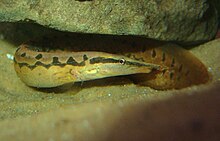Zig-zag eel
| Zig-zag eel | |
|---|---|

| |
| Scientific classification | |
| Domain: | Eukaryota |
| Kingdom: | Animalia |
| Phylum: | Chordata |
| Class: | Actinopterygii |
| Order: | Synbranchiformes |
| Family: | Mastacembelidae |
| Genus: | Mastacembelus |
| Species: | M. armatus
|
| Binomial name | |
| Mastacembelus armatus (Lacepède, 1800)
| |
| Synonyms[2] | |
| |
The zig-zag eel (Mastacembelus armatus Scopoli, 1777[3]), also known as the Baim[4],tire-track, tire-track spiny- or marbled spiny eel,[2] is a species of freshwater ray-finned fish in the family Mastacembelidae. It is native to the riverine systems of the Indian Subcontinent (India, Bangladesh, Pakistan, Nepal), Sri Lanka, Malaysia,Thailand, Vietnam, Cambodia, Indonesia, and other parts of South and Southeast Asia. The species was initially described as Macrognathus armature (Lacepède, 1800).[5] Other common names for this popular captive species include the leopard spiny eel[6] and white-spotted spiny eel.
This eel has remained fairly popular as an aquarium fish for years, owing to its unique appearance and behaviors. Additionally, like other species of eels throughout the world, the zig-zag eel serves as a viable protein and food source for humans, aquatic reptiles, birds and other, larger fishes throughout much of its range.[7][2]
Description
[edit]
Mastacembelus armatus is a large elongated fish that has a snake-like body without pelvic fins. Its anal and dorsal fins are elongated and are connected to the caudal fin. The dorsal fin is preceded by numerous spines.[8] The back is dark beige in color while the head is silver-beige. The body's color is dull brown and the belly is a lighter shade of brown. The body may also be marked with brown circular patterns. The body also have one to three darker longitudinal zigzag lines that connect to form a distinct reticulated pattern that is restricted to the dorsal two-thirds of the body. The eyes have brown stripes running laterally through them.[7][2]
Mastacembelus armatus can reach up to 36" (91 cm) in its natural habitat but does not usually exceed 20" (51 cm) in captivity.[7][2]
Despite its eel-like appearance, Mastacembelus armatus is not considered a true eel.[8]
Habitat
[edit]Mastacembelus armatus are nocturnal fish that thrive in highland streams, lowland wetlands, still waters, coastal marshes and rivers with sandy or rocky riverbeds and heavy vegetation. They are common during the tropical summer months and will dwell in canals, lakes and other floodplain areas during the flood season.[7][2]
In the aquarium
[edit]
Aquarium maintenance
[edit]Mastacembelus armatus are bottom dwellers and occasional substrate diggers[8] and burrowers. Those that are 6" (15 cm) long do well in tanks measuring 36" (91 cm) with a capacity of 35 gallons (132 liters). However, larger M. armatus necessitate aquariums measuring at least 48" (122 cm) with 55 gallons (209 liters) capacity. Zig-zag eels do well in freshwater or slightly brackish aquatic environments (produced by adding two teaspoons of sea salt (not iodated) per 21⁄2 gallons of water)[8] with 6 to 25 dH water hardness, with pH readings ranging from 6 to 8, and temperatures that are maintained between 73 and 81 °F (23 to 27 °C).[7][2]
M. armatus tend to uproot plants and disturb decorations.[8]
Compatibility
[edit]Although zig-zag eels are often combined with medium to large-sized gouramis, knifefish, danios, loaches, Loricariids, eartheaters, acaras, Cichlasomines and Asian catfishes in a community fish aquarium, they are not normally mixed with small-sized fish, because tire track eels are observed to prey upon smaller fish. Mixing them with fish belonging to the same species is also not recommended.[7][2] This is because they are aggressive to members of the same fish family but peaceful to other fish species with similar care level requirements, size and temperament.[8][9]
Feeding
[edit]Being nocturnal carnivores, zig-zag eels forage on benthic insect larvae, earthworms, blackworms and some submerged plant material. In an aquarium setting, they require live foods in their diet such as live fish, tubifex worms, brine shrimps, mosquito larvae, frozen bloodworms, cyclops, krill and ocean plankton.[7][2][8]
Reproduction
[edit]Male and female zig-zag eels are only distinguishable when mature. Females are normally plumper than males. Although their fecundity in the wild is high, there are no known successful breeding programs in captivity.[7][2]
References
[edit]- ^ Fernado, M.; Kotagama, O.; de Alwis Goonatilake, S. (2019). "Mastacembelus armatus". IUCN Red List of Threatened Species. 2019: e.T166586A60592409. doi:10.2305/IUCN.UK.2019-3.RLTS.T166586A60592409.en. Retrieved 19 November 2021.
- ^ a b c d e f g h i j Froese, Rainer; Pauly, Daniel (eds.). "Mastacembelus armatus". FishBase. August 2019 version.
- ^ Integrated Taxonomic Information System, National Museum of Natural History, Washington, D.C., Mastacembelus armatus (Lacepède, 1800), Taxonomic Serial No.: 172692, 2007, retrieved on:5 June 2007.
- ^ "তারাবাইম রেগুলার সাইজ ১ কেজি". Retrieved 14 September 2024.
- ^ Eschmeyer, William N.; Fricke, Ron & van der Laan, Richard (eds.). "'Macrognathus armatus". Catalog of Fishes. California Academy of Sciences. Retrieved 13 November 2019.
- ^ Leopard spiny eel (Mastacembelus armatus), BangkokAquarium.com, Bangkok, Thailand, 2006, retrieved on: 5 June 2007.
- ^ a b c d e f g h Butler, Rhett Ayers, Tire track Eel, Spiny Eel, White-spotted Spiny Eel (Mastacembelus armatus), Tropical Freshwater Aquarium Fish (TFAF), 1995 and Mongabay.com, 2006, retrieved on: 5 June 2007.
- ^ a b c d e f g Foster and Smith, Veterinary & Aquatic Services Department, Drs. Foster & Smith, Inc., PetEducation.com, 2007, retrieved on: 5 June 2007.
- ^ Tire Track Eel (Mastacembelus armatus), Aqua-Fish.net, 2007, retrieved on: 5 June 2007.

